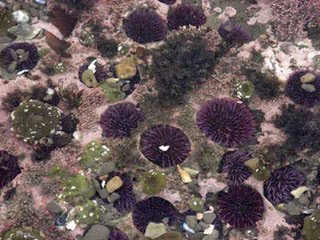MADISON – To survive in a tumultuous environment, sea urchins literally eat through stone, using their teeth to carve out nooks where the spiny creatures hide from predators and protect themselves from the crashing surf on the rocky shores and tide pools where they live.
The rock-boring behavior is astonishing, scientists agree, but what is truly remarkable is that, despite constant grinding and scraping on stone, urchin teeth never, ever get dull. The secret of their ever-sharp qualities has puzzled scientists for decades, but now a new report by scientists from the University of Wisconsin-Madison and their colleagues has peeled back the toothy mystery.
Writing today (Dec. 22, 2010) in the journal Advanced Functional Materials, a team led by UW-Madison professor of physics Pupa Gilbert describes the self-sharpening mechanism used by the California purple sea urchin to keep a razor-sharp edge on its choppers.
The urchin's self-sharpening trick, notes Gilbert, is something that could be mimicked by humans to make tools that never need honing.
To delve into the fundamental nature of the crystals that form sea urchin teeth, Gilbert and her colleagues used a variety of techniques from the materials scientist's toolbox. These include microscopy methods that depend on X-rays to illuminate how nanocrystals are arranged in teeth to make the sea urchins capable of grinding rock. Gilbert and her colleagues used these techniques to deduce how the crystals are organized and melded into a tough and durable biomineral.
Knowing the secret of the ever-sharp sea urchin tooth, says Gilbert, could one day have practical applications for human toolmakers. "Now that we know how it works, the knowledge could be used to develop methods to fabricate tools that could actually sharpen themselves with use," notes Gilbert. "The mechanism used by the urchin is the key. By shaping the object appropriately and using the same strategy the urchin employs, a tool with a self-sharpening edge could, in theory, be created." ###
The new research was supported by grants from the U.S. Department of Energy and the National Science Foundation. In addition to Gilbert, researchers from the University of California, Berkeley; Argonne National Laboratory; the Weizmann Institute of Science; and the Lawrence Berkeley National Laboratory contributed to the report.
Contact: Pupa Gilbert pupa@physics.wisc.edu 608-358-0164 University of Wisconsin-Madison















1 comment:
Thanks for the interest in this work! If anyone would like to know more about the science behind this story, we've set the original paper free to access until the 4th of February; you can find it here: http://www.materialsviews.com/details/news/969723/Ever-sharp_Urchin_Teeth_May_Yield_Tools_that_Never_Need_Honing.html
Adrian Miller
Advanced Functional Materials
Post a Comment